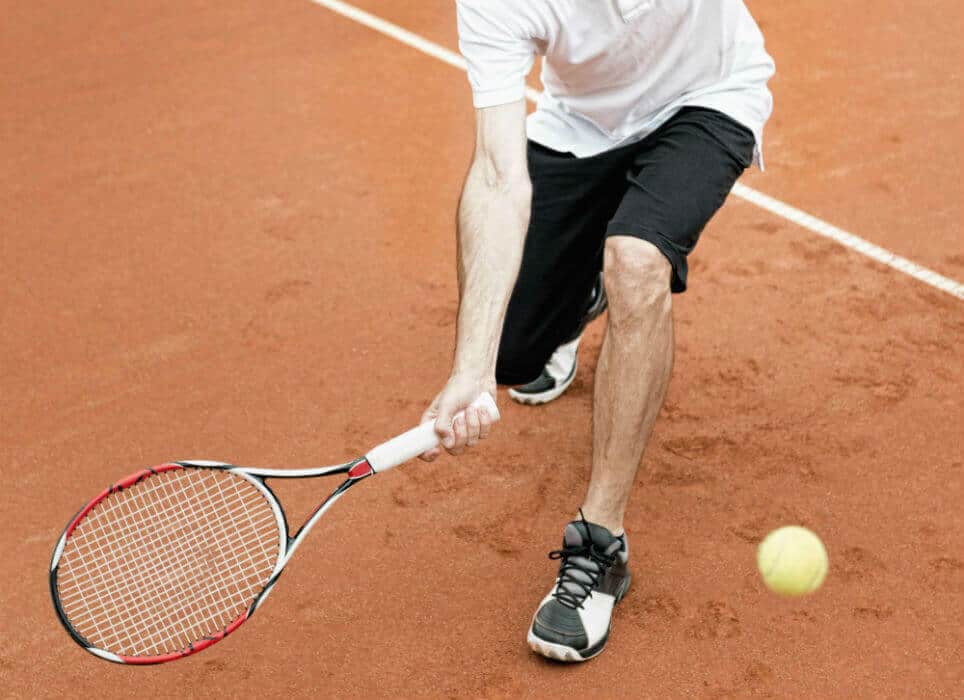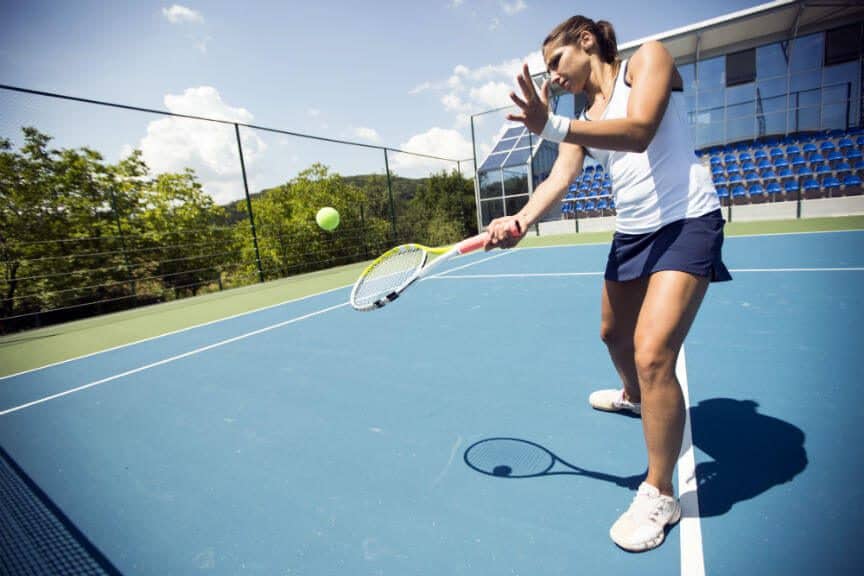The drop shot in tennis differs from most other types of strokes in that the intent is to take pace off the ball in order to make it drop just over the net. It requires a good degree of “feel” or “touch” to execute correctly.
A drop shot is a short hit ball that drops just after clearing the net and is meant to catch an opponent off guard. Usually, backspin is used when executing the stroke in order to make it more difficult to return. The drop shot stroke follows a high-to-low trajectory with the head of the racket tilted at an upward angle throughout the motion. While a good drop shot is performed with a full follow-through, the idea is to take some pace off the ball so that it just clears the net. This involves decreasing the racket speed on the finish.
The drop shot is often used to surprise a baseline hitter, particularly if they are not comfortable in the front part of the court. By throwing in an occasional drop shot, you can keep your opponent honest so they don’t become too comfortable on the baseline.
While the drop shot is more commonly used on clay, it can be an effective weapon on grass and hard court surfaces alike. Drop shots are more effective when they are executed closer to the net, however, it is possible to execute from anywhere on the court.
Use the Continental Grip
The continental grip works well on drop shots since it provides a natural angled position. See the article on how to grip a tennis racket for information on the continental grip as well as other commonly used grips.
In all likelihood, you will likely be holding a different grip at the onset until you decide to initiate the drop shot. You can adjust the racket to a continental grip with your non-hitting hand, just as you would with your groundstrokes.
Disguise Your Drop Shot
Try to disguise the drop shot by setting up as you normally would when hitting either a forehand or a backhand stroke. You don’t want to tip off your opponent too soon, otherwise, they will expect the shot and it will lose its effectiveness.
Start with the racket head high, similar to how you would hold it on a regular groundstroke. You want your opponent to think a powerful groundstroke is coming. You want them backing up and on their heels in order to surprise them with the drop shot.
Until you begin the forward motion of swing, everything about your technique should be exactly the same as on your groundstrokes. This will help you better disguise your shot and give your opponent less time to react.
Turn Sideways to Execute the Shot
When you initiate the drop shot, you want to turn sideways towards the oncoming ball. Your feet will be positioned similarly to when you are hitting a forehand or backhand groundstroke with your knees bent.
The bend in your knees and legs also play a role in the execution of the drop shot. You can use your knees to take some pace off the shot. This combined with the deceleration of the swing can help the ball drop short as intended.
Pivot around your back foot to set up sideways. Bring your front foot around and step into the shot. Both your shoulders should rotate simultaneously as a unit. You want to rotate your shoulders and hips around your torso.
If you typically use an open stance on your groundstrokes, use the same for your drop shot. You will still need to rotate your shoulders and hips around your torso, the only difference is your front foot will not step forward.
Tilt the Racket Head Up at an Angle
Once you are ready to initiate the drop shot, tilt the racket head up towards the sky at an angle. Your hitting arm should be slightly bent at the elbow. Keep the arm and grip relaxed to help you ease up on the shot.
Your non-hitting arm should point in front of you towards the ball. This helps to guide the shot and serves as a counterbalance to the hitting arm. Your weight at this point will shift to your front leg for balance.
If you normally use your elbow to point towards the ball or use your hand to guide your racket back on your groundstrokes, use the same technique on your drop shots. Additionally, if you normally hit your shots with an open stance, do the same for the drop shot.
Hight to Low Motion on Swing
The motion on the drop shot differs from other groundstrokes in that it follows a high-to-low trajectory. The motion is downward at an angle with a soft forward finish. You want to swing the racket at about a 45-degree angle, though this can vary depending on the situation.
Some players will swing down at a greater angle to generate more backspin. But the most important part of the drop shot is to absorb the speed of the ball so it leaves the strings with very little pace.
You don’t want to chop the ball either. This will generate a lot of underspin but also increases the likelihood that the ball will float too long and you will no longer end up with the shot you intended to make.

Lead with the Bottom Edge of the Racket
You should lead with the bottom edge of the racket. This allows you to take some pace off the ball and assures that the racket head is positioned correctly. It will also help generate some backspin on the ball.
Regardless of whether you are performing a forehand drop shot or a backhand drops shot, the bottom edge of the racket will always lead. It’s not necessary to tilt the racket up too much, just a slight 10 to 15-degree angle can be enough to work.
Applying Backspin to the Ball
While a drop shot can be performed with little backspin, adding it to the stroke will make it even more difficult for your opponent to return. Backspin is created by adjusting the angle of the racket head and the trajectory of motion.
Depending on how hard the ball is coming at you or how much spin you want to put on the ball, you can adjust either to give the shot more or less spin. Generally speaking, the more angled the racket the greater spin can be generated – to a point.
Contrary to what many players assume, it’s not necessary to brush the bottom of the ball to generate a drop shot. If you swinging at a downward angle, this will generate topspin even if you make contact with the back of the ball.
Decelerate Through Contact
Unlike other groundstrokes, the drop shot is executed by decelerating the racket swing through contact. You want to guide the ball on the follow through. This is where feel becomes important.
If you slow down too much it might result in hitting the ball into the net, while not decelerating enough can lead to a deeper shot which your opponent will be able to more easily return.
Deceleration does not mean swinging down and stopping abruptly. The idea is not to “chop” the ball. You need to continue your swing forward and up again to finish, in order for the shot to be effective.
Don’t Stop on the Follow Through
There is a difference between decelerating through contact and stopping the motion of the swing following contact. You do not want to stop after contact. You want to make sure you follow through, but slow down the swing on the follow through.
The follow-through on a drop shot will be shorter and more downward in trajectory than a standard groundstroke. Still, you need to guide the ball as you finish off your swing. Some forward motion is still necessary during the finish.
If you are following through on your backhand side, stick out your chest and open up your non-hitting arm for counterbalance, similar to what you would do on a backhand groundstroke.
Avoid Opening Shoulders Too Soon
One mistake beginning players often make is opening up too soon. The stroke is performed from your side. Therefore, you should not open your shoulders until the very end of the stroke. Keep your chest and shoulders sideways through contact.
The reason you want to avoid opening up early is it will throw off your shot. You might end up placing the shot wider than intended or it may cause the ball to drop too soon, possibly ending up at the net.
Remember also that you want to disguise your shot for as long as possible. Once you open your shoulders you make it more obvious to your opponent that you are hitting a drop shot and they will have more time to react.
Here’s a great video that walks you through the drop shot fundamentals:
Forehand and Backhand Drop Shots
The drop shot can be executed from either your forehand or backhand side. The technique remains effectively the same. You turn sideways towards the side of the swing and lead with the bottom edge of your racket.
The only difference, besides the forward vs reverse motion of the arm swing, is the part of the hand used to guide the racket forward. For the forehand use the heal of your hand to lead the racket. For the backhand drop shot use the side of your hand to lead.
This is similar to a slice or backspin shot. The positioning of the hand is effectively the same. You will just be taking pace off your shot and placing the ball short, just past the net rather than deep in your opponent’s court.
If you use a more traditional forehand, you will use your non-hitting hand to guide the racket back only on the backhand. If you use a modern forehand technique, you might use it to guide the racket back on the forehand as well.
The slice shot is typically best executed using a one-handed backhand. However, there are players that can use the two-handed backhand effectively to hit a drop shot. As long as your are able to take pace off the ball, either could potentially work.
When to Use the Drop Shot
While the drop shot can be used at any point to surprise your opponent, one very effective approach is to keep your opponent backed up beyond the baseline just before executing the shot.
You achieve this by hitting deep balls with heavy topspin. Once you sense your opponent is getting comfortable in the back, that’s when you can catch them off guard with a drop shot.
Drop shots can be executed when close to the net as well. Being up closer gives you the opportunity to hit the drop shot at a wider angle. This can put the ball further out of reach of your opponent.
Generally speaking, you want to be well within the baseline to hit your drop shot if possible. It’s very difficult to hit a good drop shot from the baseline or beyond. Even for the pros.
Your goal should be to catch your opponent off guard when they are positioned outside of the court boundaries. Of course, you can also use the drop shot to tire your opponent out by repeatedly forcing them up to the net.
Recovery After Hitting a Drop Shot
After you hit your drop shot, be sure to get back in a ready position. Don’t stop to admire your shot. If possible, get up to the net. You want to use this opportunity to go on the offensive.
By moving up to the net you put yourself in a better position to return your opponents shot. Chances are they will just be able to get the ball back, setting you up for a quick volley finish.
If you are unable to get up to the net, at least position yourself in the middle of the court. It’s very likely that your opponent will follow a drop shot with another drop shot. Be prepared to move up.
Practice to Get the Feel Down
As mentioned previously, executing the drop shot requires touch. You want to practice the shot regularly to develop the right feel. One way to do this is to have an opponent stand just beyond the service line and feed you shots over the top while you practice the drop shot.
If possible, practice from different distances from the net. Likewise, try to practice from different sides of the court. You will likely be more effective from the middle and closer to the net. However, you want to be prepared for all possible situations.
It will take a while to get the ball to drop perfectly over the net. When learning the technique, focus more on the decelerated motion with follow through. You can eventually perfect the slice, but it should not be the primary concern when learning the shot.
Like any other stroke, the more you repeat the motion the more it will become intuitive. Getting a sense of when to use the shot is also important. You need to learn to read your opponent so that you can execute it at the right time. This will eventually develop when using the shot during matches.
Share this Post

